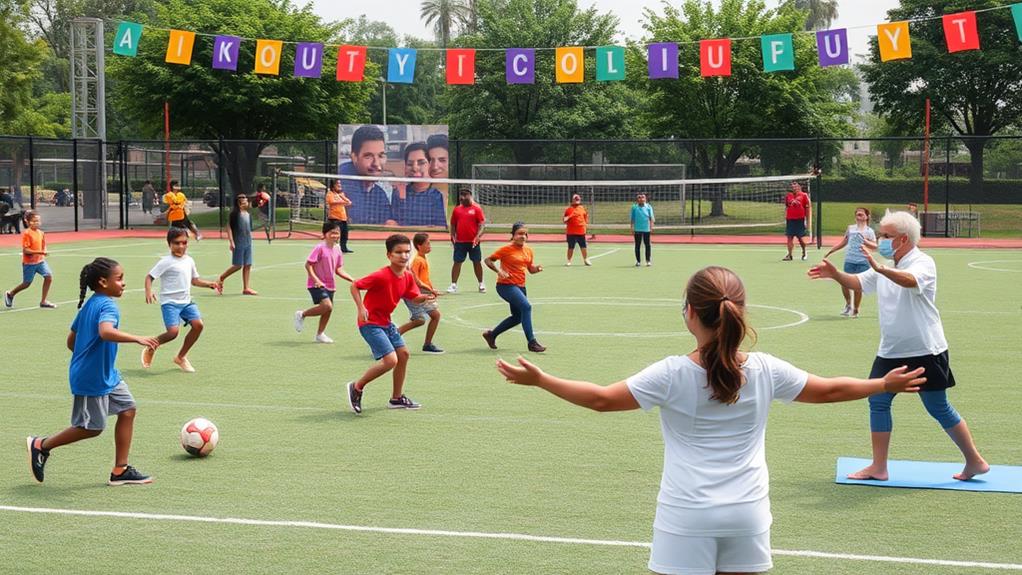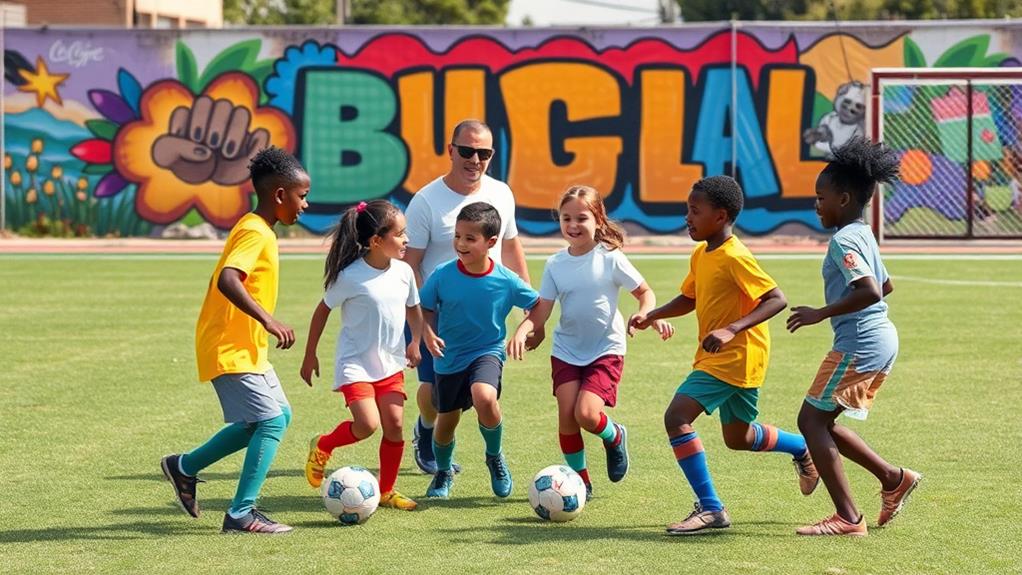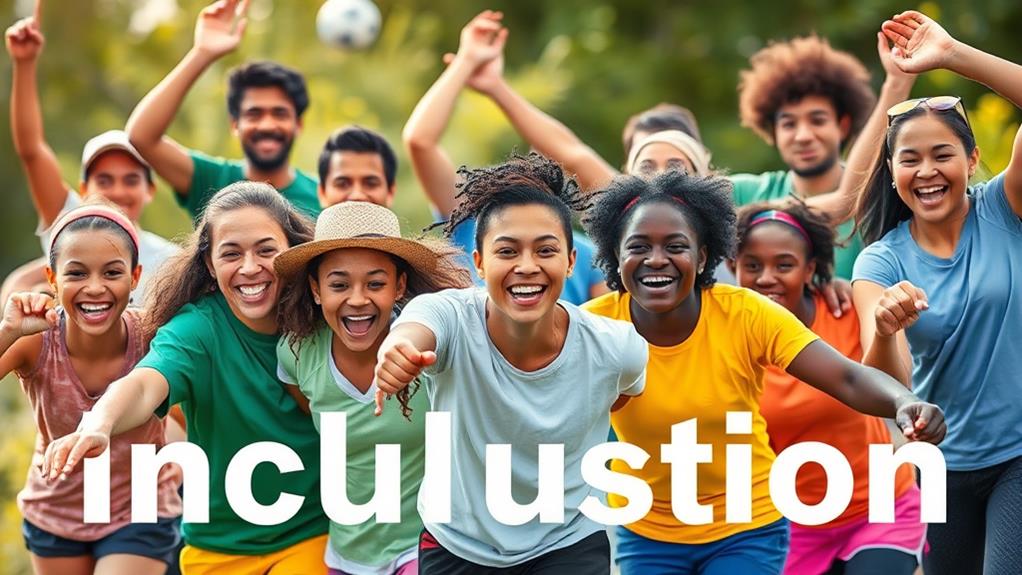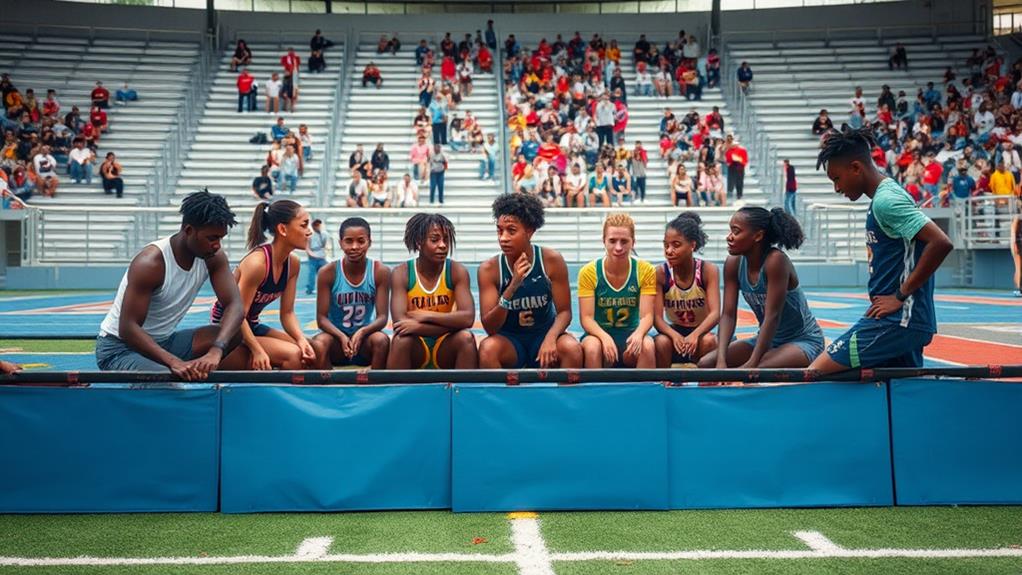Sports can empower marginalized groups and promote social inclusion by breaking down barriers and fostering a sense of community. When individuals engage in team activities, they build relationships, foster self-esteem, and enhance their overall well-being.
Inclusive sports environments invite everyone to participate, regardless of age, gender, or ability, creating safe spaces for underrepresented individuals, such as women and LGBTQ+ athletes.
However, financial, cultural, and accessibility challenges can hinder participation. For example, high costs associated with equipment, membership fees, and transportation can exclude low-income individuals.
Cultural barriers, such as language differences or conflicting values, can also limit access. Additionally, inaccessible facilities or lack of adapted equipment can prevent individuals with disabilities from participating.
Advocating for inclusive policies and support systems can address these challenges. This can include initiatives such as scholarships or financial aid, cultural sensitivity training for coaches and staff, and infrastructure modifications to ensure accessibility.
By promoting inclusive sports environments, we can create a future where everyone feels they belong and can thrive.
Overview of Social Inclusion

Social inclusion is the foundation of a society where everyone feels they belong and can actively participate. It involves enhancing the opportunities and dignity of marginalized groups, ensuring they can engage meaningfully within their communities. This leads to a sense of belonging and acceptance, allowing individuals to embrace their identities while fulfilling valued roles.
Involving diverse groups is crucial for social inclusion. When people from different cultural, linguistic, and religious backgrounds participate together, it breaks down barriers and fosters understanding. For instance, sports can serve as a powerful tool, promoting interaction and building social cohesion and integration among individuals from various backgrounds.
Social inclusion is essential across demographics. Age, gender, ability, and socio-economic status all play a significant role in creating inclusive environments. Empowering marginalized groups through inclusive initiatives enables everyone to thrive.
This enriches the community and highlights the beauty of diversity. Ultimately, social inclusion paves the way for a stronger, more vibrant society where everyone can participate and contribute to a collective future.
Sports as a Catalyst
Sports Unite Communities
Sports have the power to transform communities by breaking down cultural, linguistic, and religious barriers. For instance, community-specific leagues, such as those for LGBTQ+ teams, bring diverse groups together through shared activities, enhancing social networks and fostering a sense of belonging among marginalized groups.
Empowering Youth
Engaging youth in after-school sports programs is crucial. It not only boosts participation rates in underserved neighborhoods but also cultivates a sense of community and active citizenship.
These programs promote physical activity while developing valuable life skills, ultimately empowering marginalized youth.
Promoting Social Cohesion
Sports events and competitions serve as platforms for dialogue, promoting social cohesion and reconciliation, especially in conflict-affected areas.
By creating safe spaces for interaction, sports address the barriers that often isolate individuals from their communities.
Advocating for Change
You have the power to advocate for and support initiatives that leverage sports as a catalyst for social inclusion.
Sports have the potential to unite people, empower marginalized groups, and foster understanding, creating a more inclusive society where everyone thrives through the joy and connection that sports bring.
Education and Empowerment

Team activities lay a foundation for personal growth and educational success among youth. They offer more than just physical benefits, creating opportunities for marginalized youth to feel empowered and included in their communities. Programs like Play for Change integrate learning with physical activity, teaching essential life skills such as teamwork, discipline, and leadership.
Participating in sports boosts self-esteem and confidence. When you participate in sports, you're not just building your athletic abilities; you're also improving your self-image. This confidence often translates into better academic performance, as evidence shows that young athletes tend to achieve higher educational success.
Structured sports initiatives provide mentorship and resources, guiding youth toward improved social and educational opportunities.
Community engagement through sports cultivates a supportive environment. Sports programs help bridge gaps for marginalized youth, providing a sense of belonging and purpose.
By participating in these programs, youth enhance their own life skills and contribute to a supportive community. In essence, sports serve as a powerful tool for empowerment, enabling youth to overcome barriers and strive for a brighter future.
Gender Equality in Sports
Gender Equality in Sports: Breaking Down Barriers
The fight for equal representation and resources in sports is gaining momentum, and opportunities for personal growth and empowerment are emerging. Inclusive sports environments foster diversity, allowing female athletes to thrive. However, barriers to participation persist, such as cultural expectations and financial constraints.
Safe Environments for Girls
Sports organizations are implementing policies and programs to create safe environments for girls. These initiatives encourage participation, enhance self-esteem, and develop leadership skills among young women, breaking down societal barriers that have long hindered their involvement.
For example, the National Women's Soccer League has introduced programs to increase girls' participation in soccer.
Challenges Remain
Despite these advancements, female athletes still face significant challenges. They receive limited media coverage and sponsorship opportunities compared to their male counterparts. This disparity highlights the ongoing need for advocacy and support to improve the representation of women in sports.
Broader Community Outcomes
When you champion gender equality in sports, you contribute to broader community outcomes. It creates a ripple effect that benefits everyone, as seen in the increased participation of girls in sports and the development of leadership skills.
Health and Well-being Benefits

Participating in sports significantly improves health and well-being, especially for marginalized communities. Engaging in physical activity through organized sports reduces the risk of chronic diseases and promotes overall health.
Regular exercise alleviates symptoms of anxiety and depression, leading to improved mental health outcomes.
Community sports initiatives provide structured environments for social connections. These connections enhance emotional well-being and combat feelings of isolation. As you interact and collaborate with others, you'll notice a significant boost in self-esteem and confidence, particularly for those who've faced challenges related to identity and acceptance.
Community sports programs serve as platforms for health education, raising awareness about nutrition and healthy lifestyle choices. By participating, you empower yourself and others, fostering a culture of well-being.
The benefits of sports extend beyond physical fitness, creating a supportive community that uplifts marginalized groups and enhances overall quality of life. Your involvement in sports can be a transformative experience for both you and your community.
Conflict Resolution Through Sports
Sports Can Resolve Conflicts
Sports have a profound impact on conflict resolution, going beyond their well-known health benefits.
Organized sports programs can bridge divides in communities affected by conflict, fostering social cohesion among marginalized groups.
Initiatives like "Peace and Sport" promote reconciliation by creating platforms for dialogue, enabling individuals from different backgrounds to engage in meaningful interactions.
These sports events empower youth, enhancing their communication skills and fostering collaboration, essential for effective conflict resolution.
Sports build relationships and a sense of community engagement, significantly reducing tensions and creating an environment conducive to understanding and peace.
In post-conflict regions, sports have a profound impact, illustrating their effectiveness in promoting harmony.
Embracing sports as a means of conflict resolution can lead to a more inclusive society, where empowerment and unity prevail over division and strife.
By leveraging sports as a peace-building tool, we can create a more harmonious and united society.
Sports have the power to bring people together, resolve conflicts, and promote understanding.
How Does Sports Promote Social Inclusion and Empower Marginalized Groups?
Sports, especially the importance of youth sports, serve as a platform for social inclusion and empowerment of marginalized groups. By providing opportunities for participation, teamwork, and skill development, sports help break down barriers and foster a sense of belonging and self-confidence among individuals who may feel marginalized in society.
Challenges to Inclusion

Financial Barriers to Inclusion
Financial constraints prevent many marginalized groups from participating in sports.
Registration fees and equipment costs can be prohibitively expensive, making it difficult for individuals from low-income backgrounds to engage in sports. For instance, the cost of hockey equipment can range from $1,000 to $2,000, making it inaccessible to many.
Cultural Barriers to Inclusion
A male-centric sports culture often discourages women and LGBTQ+ individuals from participating in sports.
Women and LGBTQ+ individuals often feel unwelcome, leading to a lack of participation opportunities. For example, a study found that 80% of LGBTQ+ athletes reported feeling uncomfortable coming out to their teammates.
Accessibility Barriers to Inclusion
Aging infrastructures often lack accessibility features, limiting options for disabled athletes.
Inadequate facilities for trans and non-binary athletes create unsafe environments, further deterring their participation. For instance, many locker rooms lack private areas for trans and non-binary athletes, making them feel uncomfortable.
Solutions to Inclusion Challenges
To empower marginalized groups, we must address these challenges.
Advocating for better funding, comprehensive inclusivity training, and upgrading facilities to meet diverse needs can create inclusive sports environments. By doing so, we can ensure that everyone has the chance to participate and thrive in sports.
Future Directions and Advocacy
Advocating for Inclusive Sports Programs
Addressing challenges to inclusion in sports is crucial for creating a more inclusive sporting world. To achieve this, advocacy efforts should focus on promoting community engagement, which helps build social networks that uplift marginalized groups, such as individuals with albinism and other underrepresented identities.
Collaboration is Key
Collaboration with local and international organizations is essential for securing resources and increasing participation in inclusive sports programs.
Ongoing training and capacity-building initiatives, like the TAFISA Certified Leadership Course, equip stakeholders with the necessary skills to champion inclusive sports practices.
Policies for a Safe Environment
Developing and enforcing policies that protect participants from discrimination is crucial for ensuring safe environments for all athletes.
Enforcing these policies requires engaging diverse leadership within sports organizations, driving cultural change, and fostering an atmosphere that welcomes individuals from all backgrounds and abilities.
Creating a Future of Inclusion
By working together, we can create a future where social inclusion is a reality, making sports a vehicle for empowerment and unity.
To achieve this, we must take action and advocate for more inclusive sports programs, ensuring that everyone has access to participate and thrive.
Questions and Answers
How Can Social Inclusion Impact Sport?
Social inclusion has a profound impact on sport, fostering community engagement and breaking down access barriers. This is achieved by creating equitable opportunities, allowing diverse participants to thrive and enrich cultural exchange.
For instance, inclusive sports programs can bring together people from different racial, ethnic, and socioeconomic backgrounds, promoting mutual understanding and respect.
Inclusive policies enhance youth development and skill building, as they provide opportunities for young athletes to develop their skills and reach their full potential. This, in turn, improves teamwork dynamics, as athletes learn to work together towards a common goal.
Role models emerge in these environments, inspiring others to participate and promoting health benefits that extend beyond the playing field.
When everyone is involved, sports become a powerful tool for connection and personal growth, benefiting individuals and communities alike.
How Do Sports Promote Diversity and Inclusion?
Sports promote diversity and inclusion by fostering team dynamics that celebrate diverse representation. This is achieved through cultural exchange, where athletes from different backgrounds engage with each other, building empathy and understanding.
For example, when athletes from different countries or regions come together to compete in international tournaments, they share their unique cultural practices, traditions, and values, promoting cross-cultural understanding.
Accessibility initiatives ensure everyone can participate. For instance, the Special Olympics organization provides opportunities for athletes with intellectual disabilities to participate in sports, promoting inclusivity and equality.
Similarly, the National Wheelchair Basketball Association offers adaptive sports programs for athletes with physical disabilities.
Inclusive coaching empowers athletes of all backgrounds. Coaches who value diversity and inclusion create a positive team environment, encouraging athletes to bring their unique perspectives and experiences to the game.
This helps athletes feel valued and supported, leading to better performance and overall well-being.
Community engagement encourages intergroup dialogue. Sports events often bring together people from different racial, ethnic, and socioeconomic backgrounds, promoting social cohesion and understanding.
For example, community-based sports programs, such as the YMCA's Youth Sports Program, offer a safe space for children from diverse backgrounds to interact, build relationships, and develop social skills.
Advocating for equity in sports helps create environments where all athletes feel valued and supported. By promoting diversity and inclusion, sports organizations can break down barriers and provide equal opportunities for all athletes, regardless of their race, gender, religion, or ability.
This ultimately enriches the sporting experience for everyone involved.
In What Ways Have Sports Played a Role in Social Integration in Canada?
Sports Foster Community Engagement
Sports in Canada play a vital role in social integration by fostering community engagement. For instance, local sports leagues and clubs bring people together, creating opportunities for cultural exchange and socialization. This helps build stronger, more cohesive communities.
Accessibility Initiatives Promote Inclusion
Accessibility initiatives ensure everyone can participate in sports, regardless of their abilities. For example, the Canadian Paralympic Committee provides opportunities for athletes with disabilities to participate in sports and compete at the national and international levels. This promotes inclusivity and breaks down social barriers.
Sports Enhance Overall Well-being
Participating in sports has numerous health benefits, which contribute to overall well-being. Regular physical activity reduces the risk of chronic diseases, such as heart disease and diabetes, and improves mental health.
Team Dynamics Develop Leadership Skills and Identity
Through team sports, individuals develop essential leadership skills, such as communication, teamwork, and problem-solving. This helps individuals form their identities and build confidence.
For example, youth sports programs, like the YMCA's Youth Leadership Development program, focus on developing leadership skills through sports.
Economic Opportunities and Volunteer Involvement
Sports also create economic opportunities and encourage volunteer involvement. Professional sports teams generate revenue and create jobs, while volunteer coaches and officials contribute to the development of community sports programs.
This helps build stronger, more vibrant communities.
What Are Social Inclusion Groups?
Social inclusion groups aim to enhance community engagement and empower marginalized populations.
These groups achieve this goal by fostering cultural exchange and creating accessible environments. For instance, they organize disability sports and mentorship programs that bring people together and promote understanding.
By offering volunteer opportunities, social inclusion groups strengthen team dynamics and grassroots movements, ultimately raising public awareness about the challenges faced by diverse communities.
Getting involved with social inclusion groups helps build a more inclusive society, where individuals can thrive and connect meaningfully.